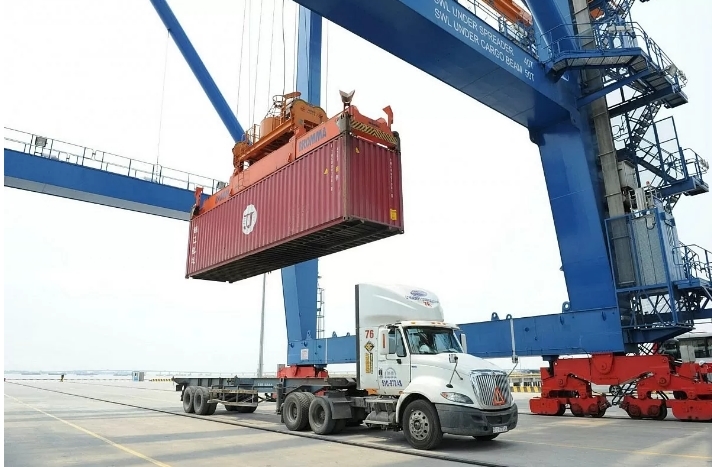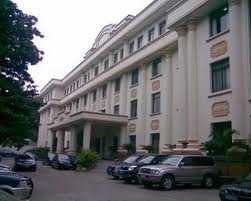From trade deficit to trade surplus: A mark of half a century of Vietnamese goods integration
Tuesday, May 6,2025
AsemconnectVietnam - 50-year import-export journey is a testament to the country's tireless efforts in integrating into international economy and improving production capacity.
Vietnamese goods affirm their position
These days, the whole country is eagerly looking forward to day of Southern Liberation and national reunification with a cheerful spirit and confidence. This is also an opportunity for us to look back at a bright spots in the country's socio-economic picture to see efforts of entire Party and people to make economy shine as bright as it is today.
It can be said that if history of formation and development of Vietnam's trade sector over the past 50 years (1975-2025) is a bright picture, export sector in recent years has many bright colors, vividly demonstrating success of renovation policy initiated and led by the Party.
Looking back at the years after the country's reunification, foreign trade was one of issues that the state paid special attention to by establishing specialized agencies, searching for and promoting export of key products. However, at that time, import and export activities were still facing numerous difficulties, and Vietnam had almost no key export products.
After 1975, Vietnam faced many challenges: devastated infrastructure, a centrally planned economy and a shortage of raw materials and technology. Import and export activities mainly relied on aid from socialist countries, with export and import turnover at very low levels. In 1986, total export turnover reached only about 789 million USD, while import turnover was 2.2 billion USD, leading to a rather serious trade deficit.
Not to mention, although it was an agricultural country, before 1986, Vietnam had to import rice because domestic production could not meet domestic consumption demand. In 1986, Vietnam implemented a renovation policy, shifting from a planned economy to a socialist-oriented market economy. This paved a way for improving business environment, attracting foreign investment and promoting exports.
Expanding markets and diversifying products
The signing of Bilateral Trade Agreement with the United States in 2000 and joining World Trade Organization (WTO) in 2007 marked an important turning point in Vietnam's international economic integration process. Export turnover grew strongly, reaching 72.2 billion USD in 2010. Structure of export goods also shifted positively, with an increase in processed industrial products such as electronics, machinery and equipment. Impressive import-export figures of this period opened up import-export opportunities, affirming a bright picture in market in the following years.
A period of 2011-2020 continued to affirm position of Vietnamese goods in international market. During this period, Vietnam continued to sign many free trade agreements (FTAs) with major partners such as EU, Korea and ASEAN countries. Export turnover in 2020 reached 281.5 billion USD, while imports were 262.7 billion USD, making Vietnam one of the countries with a high trade surplus. Key export items include phones, computers, textiles and footwear.
In 2024, total import and export turnover of goods reached 786.29 billion USD, an increase of 15.4% over the previous year, of which exports increased by 14.3%; imports increased by 16.7%. Trade balance of goods had a surplus of 24.77 billion USD. The year 2025 continued to start with positive signals for import and export activities. General Statistics Office's report shows that total import-export turnover of goods in the first quarter reached 202.52 billion USD, up 13.7% over the same period last year. Of which, exports reached 102.84 billion USD, up 10.6%, while imports reached 99.68 billion USD, up 17.0%. Trade balance of goods still maintained a trade surplus of 3.16 billion USD, affirming stability and competitiveness of Vietnamese economy.
In the first 3 months of this year, export growth came from both domestic and foreign-invested (FDI) sectors. In particular, domestic economic sector reached 30.34 billion USD, up 15.3%, showing that domestic enterprises are increasingly "growing their role", no longer relying too much on the FDI sector.
In 2025, the Government has set a target of domestic economic growth of over 8% - 10% and aims for double-digit growth in the next period. In particular, export is identified as one of three main growth drivers of the economy, in the troika.
Contributing to the whole country to successfully achieve goals set by the Government, in 2025, Ministry of Industry and Trade sets a target of import-export turnover growth of about 12% compared to 2024.
Source: Vitic/ congthuong.vn
These days, the whole country is eagerly looking forward to day of Southern Liberation and national reunification with a cheerful spirit and confidence. This is also an opportunity for us to look back at a bright spots in the country's socio-economic picture to see efforts of entire Party and people to make economy shine as bright as it is today.
It can be said that if history of formation and development of Vietnam's trade sector over the past 50 years (1975-2025) is a bright picture, export sector in recent years has many bright colors, vividly demonstrating success of renovation policy initiated and led by the Party.
Looking back at the years after the country's reunification, foreign trade was one of issues that the state paid special attention to by establishing specialized agencies, searching for and promoting export of key products. However, at that time, import and export activities were still facing numerous difficulties, and Vietnam had almost no key export products.
After 1975, Vietnam faced many challenges: devastated infrastructure, a centrally planned economy and a shortage of raw materials and technology. Import and export activities mainly relied on aid from socialist countries, with export and import turnover at very low levels. In 1986, total export turnover reached only about 789 million USD, while import turnover was 2.2 billion USD, leading to a rather serious trade deficit.
Not to mention, although it was an agricultural country, before 1986, Vietnam had to import rice because domestic production could not meet domestic consumption demand. In 1986, Vietnam implemented a renovation policy, shifting from a planned economy to a socialist-oriented market economy. This paved a way for improving business environment, attracting foreign investment and promoting exports.
Expanding markets and diversifying products
The signing of Bilateral Trade Agreement with the United States in 2000 and joining World Trade Organization (WTO) in 2007 marked an important turning point in Vietnam's international economic integration process. Export turnover grew strongly, reaching 72.2 billion USD in 2010. Structure of export goods also shifted positively, with an increase in processed industrial products such as electronics, machinery and equipment. Impressive import-export figures of this period opened up import-export opportunities, affirming a bright picture in market in the following years.
A period of 2011-2020 continued to affirm position of Vietnamese goods in international market. During this period, Vietnam continued to sign many free trade agreements (FTAs) with major partners such as EU, Korea and ASEAN countries. Export turnover in 2020 reached 281.5 billion USD, while imports were 262.7 billion USD, making Vietnam one of the countries with a high trade surplus. Key export items include phones, computers, textiles and footwear.
In 2024, total import and export turnover of goods reached 786.29 billion USD, an increase of 15.4% over the previous year, of which exports increased by 14.3%; imports increased by 16.7%. Trade balance of goods had a surplus of 24.77 billion USD. The year 2025 continued to start with positive signals for import and export activities. General Statistics Office's report shows that total import-export turnover of goods in the first quarter reached 202.52 billion USD, up 13.7% over the same period last year. Of which, exports reached 102.84 billion USD, up 10.6%, while imports reached 99.68 billion USD, up 17.0%. Trade balance of goods still maintained a trade surplus of 3.16 billion USD, affirming stability and competitiveness of Vietnamese economy.
In the first 3 months of this year, export growth came from both domestic and foreign-invested (FDI) sectors. In particular, domestic economic sector reached 30.34 billion USD, up 15.3%, showing that domestic enterprises are increasingly "growing their role", no longer relying too much on the FDI sector.
In 2025, the Government has set a target of domestic economic growth of over 8% - 10% and aims for double-digit growth in the next period. In particular, export is identified as one of three main growth drivers of the economy, in the troika.
Contributing to the whole country to successfully achieve goals set by the Government, in 2025, Ministry of Industry and Trade sets a target of import-export turnover growth of about 12% compared to 2024.
Source: Vitic/ congthuong.vn
Vietnam's economic picture in first quarter of 2025
Vietnam's exports reached nearly 120 billion USD by April 15
Imports of computers, electronics and components in 3 months of 2025
Main commodity groups imported from Russia in 3 months of 2025
Vietnam sugar market - April 2025
Cassava exports in first 3 months of 2025
Iron and steel imports decreased in first 3 months of 2025
Vietnam pig and pork market - April 2025
Fruit and vegetable exports increased sharply by over 52% in March of 2025
Main groups of goods imported from France in first 3 months of 2025
Hung Hau Agriculture Corporation inaugurates HappyFood Vietnam Export Processing Plant
Vietnam’s shrimp sector embraces the green transition
Groups of goods imported from India in first 3 months of 2025
Vietnam’s cashew nut export markets in first 3 months of 2025

Plan of Hai Duong province for a period of 2021 - 2030, ...
Organize space reasonably and harmoniously, focusing on connecting Hai Duong in common development space, actively contributing to the ...Plan of Hau Giang province in a period of 2021 - 2030, ...
Sustainable forestry development program in a period of ...

Art programme honouring Ao dai opens at HCM City Book ...
An art programme to honour and promote traditional cultural values and the beauty and grace of Ao dai has opened in Ho Chi Minh City. It ...From Hanoi to Brussels – a cross-cultural musical journey
Talented youngsters to enjoy int'l football ...
Tien Linh, Thuy Trang win Vietnam Golden Ball 2024
HCM City’s ao dai festival to feature mass folk dance with ...



